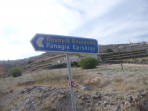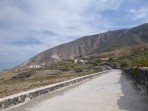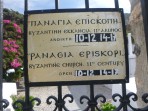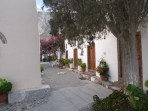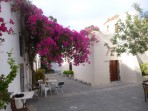Church of Panagia Episkopi - Santorini island
Episkopi Gonias, Church of the Assumption
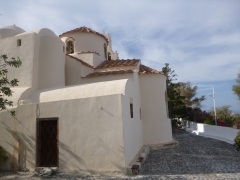
The Panagia Episkopi, or also Episkopi Gonias or the Church of the Assumption, dates back to the end of the 11th century and is the oldest church on the Greek island of Santorini. This magnificent medieval religious building is a beautiful example of Orthodox Church architecture. The church can be found in the inland village of Mesa Gonia, at the foot of Mount Profitis Ilias.
History of Panagia Episkopi
There are two popular legends connected to the origin of the church. The first one says that the event is connected with the icon of the saints (Panagia means "all saints"), which mysteriously disappeared and reappeared. The locals took this as a sign and had a new church built on the site. According to the second legend, the Emperor Alexius I Kommenos gave the order to found the church while he was wandering in the beautiful Santorinian countryside between the villages of Pyrgos and Gonia. The first recorded mention of the church of Panagia Episkopi dates back to 1207.
During the 13th century, at the beginning of the Fourth Crusade, the Venetians took control of the island and, among other things, expelled the local Orthodox bishop and replaced him with a Latin bishop. A Catholic altar was erected next to the Orthodox altar in the church of Panagia Episkopi, and the new bishop took up residence in the chapel at Skaros Rock, at the foot of the caldera. In 1537, the entire Aegean region came under the administration of the Ottoman Empire, as a result of which the representative of the Orthodox Church was able to return to the island and accepted the church of Panagia Episkopi as his episcopal seat. The Catholics, however, did not want to give up their position and so the disputes continued until 1614, when both churches were recognised (and both churches were given the right to worship in the church).
However, a complete truce between the two churches never came about. In 1827, the bishopric moved to the capital city of Fira and the property of the church was gradually expropriated. In 1915 a fire broke out in the building, destroying most of the books and church documents, but fortunately the religious icons remained intact. The earthquake of 1956 caused great damage to both the village of Mesa Gonia and the building itself. The reconstruction of the church then lasted until 1986. But while restoration work was underway in the church, all 26 mobile icons were irretrievably lost.
Appearance and interior of the church
The Church of the Assumption of the Virgin Mary is a beautiful, white to beige church that has seen several extensions over time and a beautiful bell tower. The floor plan of the main building is a Greek cross 14 metres long and a maximum width of 11 metres. The central dome and the other roofs are covered with red tiles, thus completing the very pleasant appearance of this building. There are currently five entrances.
The interior of the building is not lagging behind and is sure to impress visitors with its decoration and richness. In the past, the interior walls of the church were decorated with magnificent frescoes, which were covered with plaster during the Ottoman rule and most of them were destroyed by humidity. However, some of them have been saved and restored. Visitors can also admire several interesting icons of saints. Especially rare is the icon of Panagia Glycophilous, which is kept in a special glass case. The icon dates from the 12th century and is particularly valuable because it depicts a scene of the Virgin Mary, to whom the church is dedicated.
More touristic destinations of Santorini
Most favourite sights of Santorini: Akrotiri (archeological site), Archeological Museum of Thera, Agios Anastasios Church (Imerovigli), Panagia Platsani Church (Oia), Akrotiri Lighthouse, Ruins of Byzantine castle (Oia), Ancient-Thira (archeological site)
Resorts, beaches, sights or trips - clearly listed on the map of Santorini.
Did you visit this place and do you have some additional informations, interessting observation or photos?


